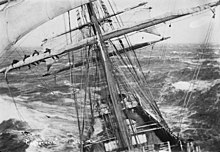Nautical operations
The plan includes leaving the dock and harbor area, the en route portion of a voyage, approaching the destination, and mooring.
[5] The practice of voyage planning has evolved from penciling lines on nautical charts to a process of risk management.
[7] Integrated systems take inputs from various ship sensors, electronically display positioning information, and provide control signals required to maintain a vessel on a preset course.
The chief mate is the head of the deck department on a merchant's vessel, second-in-command after the ship's master.
The chief mate's primary responsibilities are the vessel's cargo operations, its stability, and supervising the deck crew.
The chief mate also trains the crew and cadets on various aspects like safety, firefighting, search and rescue, and other contingencies.
When on navigational watch, the third mate directs the bridge team, maneuvering the vessel, keeping it safe and on track.
The third mate's primary duty is matters of safety, inspecting gear lockers, lifeboats, and all equipment on board ensuring that it is safe and operational.
This includes not only the engine and the propulsion system, but also, for example, the electrical power supply, devices for loading and discharging, garbage incineration and fresh water generators.
The department and its manning requirements, including the responsibilities of each rank are regulated within the STCW Convention, applicable only to the merchant fleets of countries who have ratified it.
However, they are usually also responsible for supervising and monitoring any maritime cargo on board, as well as ensuring maintenance of the deck and upper hull structure, monitoring the stability of the ship, including loading and discharging ballast water, carrying out mooring operations, and finally anchoring a ship.
[10] These include the ship engine, fuel oil, lubrication, water distillation, separation process, lighting, air conditioning, and refrigeration.
[citation needed] The chief cook is the senior unlicensed crew member working in the steward's department of a ship.
[citation needed] The chief cook directs and participates in the preparation and serving of meals; determines timing and sequence of operations required to meet serving times; inspects galley and equipment for cleanliness and proper storage and preparation of food.
[citation needed] In the Hellenistic era, as civilizations around the Mediterranean grew in size and complexity, both their navies and the Hellenistic-era warships such as galleys became successively larger.
The exact reasons are not known, but are believed to have been caused by addition of more troops and the use of more advanced ranged weapons on ships, such as catapults.
The size of the new naval forces also made it difficult to find enough skilled rowers for the one-man-per-oar system of the earliest triremes.
Fleets with large galleys were put in action in conflicts such as the Punic Wars (246–146 BC) between the Roman Republic and Carthage, which included massive naval battles with hundreds of vessels and tens of thousands of soldiers, seamen, and rowers.
[15] Most of the surviving documentary evidence comes from Greek and Roman shipping, though it is likely that merchant galleys all over the Mediterranean were highly similar.
In Latin they were called actuaria (navis) ("ship that moves"), stressing that they were capable of making progress regardless of weather conditions.
As an example of the speed and reliability, during an instance of the famous "Carthago delenda est" speech, Cato the Elder demonstrated the close proximity of the Roman arch enemy Carthage by displaying a fresh fig to his audience that he claimed had been picked in North Africa only three days past.
Other cargoes carried by galleys were honey, cheese, meat, and live animals intended for gladiator combat.
The Romans had several types of merchant galleys that specialized in various tasks, out of which the actuaria with up to 50 rowers was the most versatile, including the phaselus (lit.
[18] Richard Henry Dana Jr. and Herman Melville each had personal experience aboard sailing vessels of the 19th century.
[20] Melville described the crew complement of the frigate warship, United States, as about 500—including officers, enlisted personnel and 50 Marines.
He additionally named such positions as, boatswains, gunners, carpenters, coopers, painters, tinkers, stewards, cooks and various boys as functions on the man-of-war.




